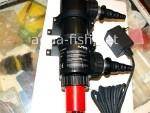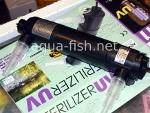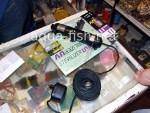Comprehensive Guide to UV Clarifiers and Sterilizers for Aquariums and Ponds
Quick Links - Answers
What You’ll Learn in This Guide
UV clarifiers and sterilizers are essential tools for maintaining clear, disease-free water in both ponds and aquariums. This guide explains how these devices work, the difference between clarifiers and sterilizers, and how to choose the right unit for your setup.
You'll learn how UV light eliminates free-floating algae, bacteria, and parasites—reducing green water and minimizing disease outbreaks. We’ll cover installation tips for different tank types, practical maintenance advice, and what to expect in terms of results and limitations. Whether you keep koi in a backyard pond or discus in a high-tech aquarium, this guide will help you harness UV technology effectively. Use the quick links above to navigate or start reading below.
📘 Introduction
Originally developed for medical and industrial sanitation, UV sterilization found its way into aquatics as a safe and effective method for keeping water clean. UV Clarifiers and Sterilizers are powerful tools for keeping aquarium and pond water clear and healthy. They control algae, bacteria, and parasites, enhancing the overall environment for fish and plants. These devices reduce the need for chemical treatments, allowing for a more natural and balanced aquatic ecosystem. Throughout this guide, we’ll distinguish between UV clarifiers (UVC)—used primarily for algae control—and UV sterilizers (UVS), which are designed to eliminate a broader range of microorganisms including parasites and pathogens.
💡 What is a UV Clarifier (UVC) and How Does it Work?
A UV Clarifier (UVC) uses ultraviolet-C light (typically around 254 nm wavelength) to remove free-floating algae spores from the water, reducing green water in ponds and aquariums. UV-C radiation penetrates the outer membranes of algae cells, damaging their DNA and rendering them incapable of reproduction. Once deactivated, these cells clump together and are removed by filtration. UVCs are particularly effective in ponds, but they also enhance water clarity in aquariums when used continuously and correctly.
🧪 What is a UV Sterilizer (UVS)? How is it Different from a UVC?
A UV Sterilizer (UVS) is similar to a UVC but operates at a higher intensity or with longer contact time, making it more effective at killing not just algae, but also waterborne bacteria and parasites. UV sterilizers are used to prevent outbreaks of diseases in both ponds and aquariums. However, not all bacteria are equally susceptible—some, like Mycobacterium and Pseudomonas, can survive due to protective biofilms or being attached to surfaces rather than free-floating.
UV systems come in several designs: the Quartz Sleeve type (most common and efficient), Wet Tube type (with water in direct contact with the lamp), and Tray type (UV lamp suspended above shallow flowing water). Quartz-sleeved units are easiest to clean and maintain.
UVC vs. UVS Comparison
| Feature | UV Clarifier (UVC) | UV Sterilizer (UVS) |
|---|---|---|
| Primary Use | Algae Control | Algae, Bacteria, and Parasite Control |
| Power | Lower | Higher |
| Typical Application | Ponds and Aquariums | Ponds, Aquariums, Disease Control |
⚙️ Choosing the Right UV System
Selecting the right UV system depends on your pond or aquarium's size, water flow rate, and goals. For general algae control, a UV clarifier will suffice; for disease prevention, a UV sterilizer is more effective. It's recommended to choose a UV unit rated for at least twice the volume of your system for efficiency.
Recommended Wattage by Tank/Pond Size
- Up to 50 L / 13 gal – 5W
- Up to 100 L / 26 gal – 9W
- Up to 200 L / 52 gal – 15W
- Up to 400 L / 105 gal – 25W
- Over 400 L – 30W or more (consider dual-lamp units)
Note: Flow rate matters—higher wattage units require slower flow for effective sterilization. Check manufacturer specs for optimal turnover rates (e.g., 1x volume/hour for sterilization; 3x for clarification).
🌿 Using UV Clarifiers in Ponds
Why Use a UV Clarifier?
Still water in ponds often leads to algae blooms. Excessive algae obscures fish, clogs filters, and reduces oxygen levels. UV clarifiers help control algae, reduce chemical usage, and maintain visual clarity. They are especially helpful in ponds with high sunlight exposure.
Step-by-Step Installation Guide
- Choose a UV clarifier slightly larger than recommended for your pond size.
- Install the UV clarifier in-line after your pond filter, connected to a suitable pump.
- Use a pre-filter to avoid clogging and place the unit in a shaded area.
- Ensure secure plumbing and avoid sharp bends that reduce flow.
- Turn on the UV clarifier and monitor algae levels over 1–3 weeks.
Maintenance Tips
- Clean the quartz sleeve monthly or as needed.
- Replace the bulb every 6–12 months, even if it still lights up.
- Check water flow to avoid bypass or clogging.
🐟 Using UV Clarifiers/Sterilizers in Aquariums
Benefits for Aquariums
UV clarifiers and sterilizers prevent free-floating algae, bacteria, and parasite outbreaks, minimizing the spread of diseases like ich and velvet. They promote water clarity and reduce reliance on medications.
Installation Tips
- Choose a UV unit rated for at least twice your tank volume.
- Install after filtration—ideally after the mechanical and biological filter stages. Never install the UV unit before the biological filter, as it may destroy beneficial bacteria before colonization.
- For HOB filters, use an external UV unit with dedicated pump or inline connection.
- For vertical tanks, mount the unit horizontally outside the tank to minimize stress on tubing.
Maintenance
Clean the quartz sleeve regularly and replace the UV bulb annually. Always turn off the unit before performing maintenance to avoid UV exposure.
⚖️ Pros and Cons of UV Systems
Pros
- Highly effective against green water and algal blooms.
- Reduces spread of waterborne diseases.
- Improves water clarity and light penetration.
- Decreases use of chemical treatments.
- Modern units are compact and efficient.
Cons
- Needs electricity—adds to running cost.
- Requires regular bulb replacement and cleaning.
- Can kill plankton and microorganisms beneficial to certain biotopes (e.g. blackwater, reef tanks).
- UV light may break down fertilizers and trace elements in planted tanks—adjust dosing as needed.
- Overuse may lead to reduced immune resistance in fish.
- Must be turned off when dosing medications, as UV can degrade them.
🚫 Safety Precautions
- Never look directly at an active UV bulb—protect your eyes and skin.
- Always unplug the unit before opening or cleaning.
- Install after the filter to avoid disrupting beneficial bacteria colonies.
- Use secure fittings and avoid water leaks near electrical components.
❓ Frequently Asked Questions (FAQs)
How often should I change the UV bulb?
Every 6–12 months, depending on usage and manufacturer recommendations. UV output decreases over time even if the bulb still lights up.
Will a UV sterilizer harm beneficial bacteria?
No, UV targets only free-floating bacteria. Filter media and substrate bacteria remain unaffected.
Can I run UV 24/7?
Yes, for maximum efficiency, continuous use is recommended. However, turn it off when using medications.
How do I check if the unit is working?
Most units have an indicator light. If not, check water clarity and inspect bulb and quartz sleeve during regular maintenance.
✅ Conclusion
UV clarifiers and sterilizers are valuable tools in both aquariums and ponds. They effectively reduce algae, bacteria, and parasites, leading to clearer water and healthier livestock. While not all pathogens are affected, and some systems may not suit all tank types, the benefits often outweigh the drawbacks when used correctly. Whether you run a koi pond, community tank, or planted aquascape, understanding and applying UV technology can lead to a cleaner, more stable aquatic environment.





